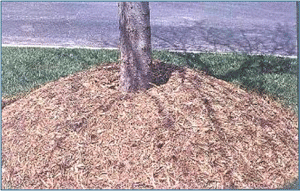The more, the better, right? In most cases, human nature being as it is, if we find something that works well, we apply more of it, take more of it, buy more of it or use it more often. Is this always a good plan? Usually not.
Balance
In all actuality, when it comes to the care of ornamentals on the acreage, a real balance is important. Other aspects of our lives set the tone for this approach and are filled with examples of the need for balance. Sure, spicy tortilla chips are tasty, but eating a super size bag of them at every meal is probably too much of a good thing - too much fat for your diet, and too much of the same flavor and texture. A better plan is to eat a few for a snack once or twice a week, and include some green veggies at mealtime instead.
Guiding Principle
When it comes to mulching, consider the following. The guiding principle is to replicate Mother Nature. In most forest settings, you'll find "leaf litter" or "arbor droppings" on the forest floor - bits and pieces of bark, twigs, faded flowers, fruits and leaves. They are usually piled up to about a 3-4 inch depth.
Seeing is believing, so the next time you want a diversion or feel the need for a "road trip", drive to a nearby forest preserve or nature center and kick your way through the trees. As you walk through, reach down and examine what's fallen off the trees. Directly underneath the droppings, you'll find that some that are decomposing into soil, and under that, you'll find black gold.....natural compost. The decomposition process is how nutrients are cycled back to the tree, eventually picked up by the roots.
This exercise emphasizes the need for areas around each tree that will allow for leaf and arbor dropping recycling. Trees planted in restricted areas, or with lots of rock or concrete around them, such as when placed near grain bins or driveways, develop poorly due to a compromised root system, in part due to the lack of nutrient recycling.
With those concepts as a foundation, when mulching around trees, consider what's best for the plant as well as what is practical for the acreage. Start by placing mulch 2 inches away from the tree trunk, and extend it as far away from the tree as is practical. Six to eight feet is not too much. Avoid mulch volcanoes - those obnoxious looking loads of mulch dumped at the base of trees. The trunk of a tree should remain open to the air; otherwise a more favorable environment for diseases such as Armillaria root rot is created.
Mulching Materials
Real men don't each quiche, and real horticulturists and arborists (and acreage owners) don't use rock mulch. Again, replicate nature by using plant by-products. Lucky for us, Mother Nature isn't choosy.........pine needles, wood chips, cypress pieces, bark nuggets, cedar chunks, ground corncobs, prairie hay, stump grindings and even cocoa bean hulls or cottonseed hulls are good for trees. Oh sure, in very windy areas rock might make sense; however the benefits of cooling the soil, suppressing weeds and recycling nutrients are lost. A particularly poor place to use rock is on acreages where a stray juvenile delinquent might feel the urge to toss a stone through the dining or ballroom window. A 2 inch depth is ideal.
Each of these materials has certain characteristics that should be considered when choosing a mulch material.
- Wood Chips - Usually free, can be obtained from tree services.
- Pine Needles - Usually free, but removing them from your pines can be detrimental. Also, using "borrowed" needles can be problematic as foliar diseases can be held on the surfaces.
- Cypress Pieces - Can be expensive. Much of cypress mulch is made from areas where trees are cut and not replanted.
- Bark nuggets - Can be pricey, but usually the larger size reduces washing and blowing away.
- Cedar Chunks - Smaller particle sized products can be lost to wind, but good overall.
- Ground Corncobs - Gives you a chance to get to know your corn farming neighbors. 2 inch size chunks are better than smaller ones.
- Prairie Hay - Can use material that isn't the finest for animals to eat, but use caution to avoid applying an overly thick layer.
- Cocoa Bean Hulls - Expensive, but can add a wonderful aroma to the landscape. Be sure to use a thin layer only, as they have a tendency to mat and cut off oxygen exchange to plant roots.
- Cottonseed Hulls - Ditto, except for the wonderful aroma.
- Stump Grindings - Free, can be obtained easily by scooping up the residue left after a tree is removed and the stump ground out. They tend to be on the coarse side, but usually make a good mulching material.

